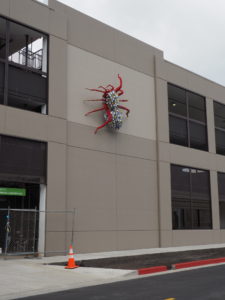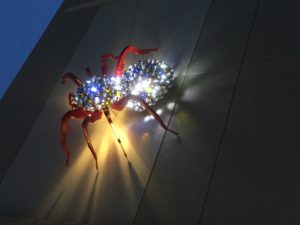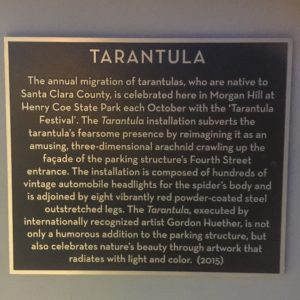Maternal metal monster invades Tokyo!
Once you see one big metal spider, you start seeing them everywhere.
Morgan Hill, California, now has its glow-in-the-dark tarantula perched alongside a parking garage. I don’t know of any other spider so glam, so wow, so poised to startle late-night pedestrians.

Bonjour, Maman! My, what big . . . everythings you have. (Photo by Charles Lindsey)
But there are others. In fact, I took a picture (above) of one last summer in Tokyo, little thinking that it was famous and had siblings around the world. I neglected even to inquire about it, assuming (as one would) that in Tokyo you must see large creatures stomping around all the time. Godzilla, after all, hangs out in Shinjuku when he’s between movies and nobody bats an eye.
The big bronze spider I saw is Maman, or “Mommy,” the creation of French-American artist Louise Bourgeois (1911–2010), whose works late in life included many varieties of metal spider sculptures. The original Maman, created in 1999, is made of stainless steel and lives at the Tate Modern in London. Six other castings, all in brooding bronze, are on display in Tokyo, Ottawa, Bilbao, Seoul, Qatar, and Bentonville, Arkansas (in Alice Walton’s museum).
Others of her spidery work include Spider (1996), which guards the National Gallery of Art Sculpture Garden in Washington, DC, and five other sites. It also roams. And racks up record sales figures at auction: $10.7 million, at the time a record for a female artist.
But Maman is Bourgeois’s biggest spider, more than thirty-three feet wide and thirty high. It was a tribute to her mother, who died when Bourgeois was twenty-one. Here is how she explained the work:
The Spider is an ode to my mother. She was my best friend. Like a spider, my mother was a weaver. My family was in the business of tapestry restoration, and my mother was in charge of the workshop. Like spiders, my mother was very clever. Spiders are friendly presences that eat mosquitoes. We know that mosquitoes spread diseases and are therefore unwanted. So, spiders are helpful and protective, just like my mother.
This is how artists make us see differently. Arachnophobes cringe at the sight of a work like Maman, especially if they peer upwards and see that the matriarch carries eggs, made of marble, in a giant sac. Bourgeois tried to cast those views, so to speak, in a different light. And like almost all spiders commonly found in the real world, her spider is benign, aloof, committed to a task that has nothing to do with those who gawk at her. They’re sturdy but delicate, menacing but protective.
“The spider is a very lonely creature,” Bourgeois said in one videotaped interview. “Of course, she is very strong. She has an invading power.”

“The Nest,” offering inspiration, and maybe disturbing dreams, at SFMoMA.
Her work The Nest (1994), above, at the San Francisco Museum of Modern Art depicts a whole family of metallic spiders, each one guarding the smaller one below it. Spider Couple (2003) has just two, entwined in a leggy embrace. Crouching Spider (2003), below, on the other hand, hums with that invading power, eyelessly challenging the viewer to pounce or be pounced upon.

“Crouching Spider,” lurking along the San Francisco shoreline for a tasty hipster.
Bourgeois’s New York home is being renovated with an eye toward public tours. She liked the place cluttered and utilitarian, once saying, “I’m using the house. The house is not using me.” Oddly, despite all the interviews and documentaries about this famous artist, I’ve been unable to find any information about how she felt about real spiders. I have no doubt the cellar spiders were weaving away in the corners of that studio when she lived there, and are working there still.




 .
.